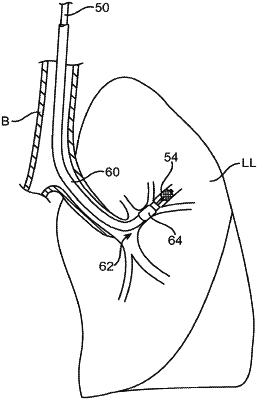| CPC A61B 5/4836 (2013.01) [A61B 5/08 (2013.01); A61B 5/085 (2013.01); A61B 5/097 (2013.01); A61B 5/6853 (2013.01); A61B 17/12104 (2013.01); A61M 16/04 (2013.01); A61M 16/0406 (2014.02); A61M 16/0866 (2014.02); A61M 25/0075 (2013.01); A61M 25/0662 (2013.01); A61F 2002/043 (2013.01); A61M 2025/0004 (2013.01); A61M 2025/0681 (2013.01)] | 20 Claims |

|
1. A method for treating a target lung compartment, said method comprising:
inserting a catheter having a detachable flow restrictive component connected thereto into an airway feeding the target lung compartment, the catheter having an obturator disposed in a central passage of a shaft of the catheter;
deploying the detachable flow restrictive component while remaining connected to the catheter in the airway feeding the target lung compartment, whereby the target lung compartment is isolated;
determining whether collateral ventilation exists in the target lung compartment while the detachable flow restrictive component remains deployed in the airway and connected to the catheter, wherein determining whether collateral ventilation exists comprises measuring air flow or accumulation of air from the isolated lung compartment through the catheter and detachable flow restrictive component; and
after determining whether collateral ventilation exists, detaching the detachable flow restrictive component from the catheter to leave said component in place in the airway if no significant collateral ventilation present; or removing the catheter together with the detachable flow restrictive component if significant collateral ventilation is determined to be present, wherein the determining and detaching steps are carried out in a single protocol;
the method further comprising shifting the obturator between a distally advanced position where it engages and elongates the detachable flow restrictive component to cause the component to assume a contracted configuration, and a proximally retracted position where it allows the detachable flow restrictive component to shorten and return to an expanded configuration.
|